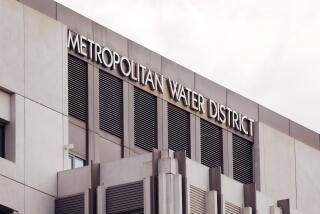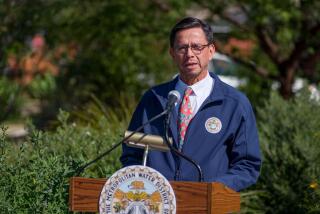Businesses get fat rebate checks for water-saving turf replacement
A tractor rumbled over 2 acres of green turf last month at the MillerCoors brewery, its mechanical rake leaving wide swaths of thirsty grass chomped up in its wake.
The once-lush knoll, by springtime, will feature a pathway of decomposed granite, a bed of river rocks and a sign encouraging water conservation.
For its water-saving efforts, the beer company is scheduled to receive a check for about $187,000 from the Metropolitan Water District of Southern California through the agency’s turf replacement rebate program.
Local and state water officials have lauded the multimillion-dollar program as a water-saving boon for the drought-stricken state. Thousands of Southland residents have applied for financial incentives to tear out and replace turf with drought-friendly foliage, a move experts say is critical to recalibrating Californians’ attitude toward water. Businesses are cashing in, too, in a big way.
Of the $85.6 million MWD has allocated for turf replacement rebates under the program, about 60% is slated for commercial customers, according to department records and officials. Commercial entities, including expansive golf courses and for-profit businesses with gigantic lots, such as MillerCoors, used around $51 million. Meanwhile, residential customers received about $34 million to replace grass.
Unlike some other turf rebate programs across California, MWD’s does not limit the size of rebates. At least three golf courses in affluent parts of Southern California are slated to receive more than $4 million, according to department records compiled for The Times in November.
Experts said the cost of rebates for large, commercial projects is a long-term investment that will help ensure future water reliability. But homeowners who have pinched pennies to replace their lawns with drought-friendly landscaping found the distribution of millions to commercial entities that could otherwise afford the cost of turf replacement irksome.
“I don’t think millions of dollars to private commercial property such as golf courses is the best use of those funds,” said Liz Crosson, executive director of Los Angeles Waterkeeper, a waterway protection and restoration organization.
MWD spokesman Bob Muir said the successful program has seen an “extraordinary” spike in participation over the last year. He defended the program’s payouts as “unprecedented action” in response to “unprecedented challenges.”
“We’re in a drought. We’re a water agency, and we’re trying to save water,” said Bill McDonnell, MWD water efficiency manager. “The water we save does not know whether it’s in your frontyard or in a private golf course. It’s water, and it’s Metropolitan’s job to save water.”
Officials at the Irwindale brewing plant have pushed to conserve water outdoors in recent years, said Ed Gharavi, MillerCoors technical services manager. Landscapers have removed several acres of turf, saving millions of gallons of water each year, he said.
The company would have probably removed a smaller portion of turf from the grassy knoll without the rebate, Gharavi said. But with removal and replacement costs estimated between $3 and $4 a square foot, the $2 rebate allowed the company to do more.
“There can be a real hesitation to invest, but we understand that water is something we need to protect,” Gharavi said. “You never know the worth of water until you don’t have it.”
Asked whether for-profit companies should receive ratepayer-funded rebates for their projects, Gharavi said: “I don’t know that I’d have a response.”
At about 94,000 square feet, the turf replacement at the MillerCoors property is small, compared with projects underway at some golf courses.
Brookside Golf Club in Pasadena is removing 870,000 square feet of turf, said David A. Sams, director of golf operations. Costs to replace it, about 70 cents a square foot, are lower than those of most other projects because officials are not buying or adding native plants that golfers “wouldn’t want to hit out of,” he said. They plan to plant about 200 trees and realign sprinkler heads in where grass used to be.
The project will cost about $600,000, much less than the $1.74 million rebate that MWD approved. The golf course will save about $80,000 a year in water costs but will spend about $60,000 a year to maintain the new non-irrigated areas, Sams said.
“We’re not doing it to save money; we’re doing it because it’s the right thing,” he said. “We were going to do this project regardless of whether we got a rebate.”
Brookside will receive a check only for the amount of money the project ultimately costs, not for the entire amount MWD approved for the replacement. The water district created a new rule in July — about two months after the $2-per-square-foot rebate went into effective — that limits the amount of rebate to the actual cost of the project, instead of giving applicants the entire amount approved based on initial estimates.
Ten entities that applied early have been grandfathered in and will receive the full rebate regardless of a project’s actual cost.
The largest of those projects is the Rancho Santa Fe Assn.’s plan to replace 810,000 square feet of turf at its golf course, according to water district records. The project cost about $1.2 million, course superintendent Tim Barrier said. MWD records show the course will receive a check for $1.62 million.
Barrier said he was so pleasantly surprised when he learned the water district was offering a $2 rebate for turf removal that he “almost choked.” The course, which serves 500 members in an affluent part of northern San Diego County, would have gradually replaced the turf even without a rebate, he said.
“If there’s an agency that wants to help us on this endeavor, then we should take advantage of it,” he said. “If we’re going to cooperate with an agency that wants to embark on a program like this, we should absolutely not be singled out as somebody that doesn’t need the money.”
Mark Gold, of UCLA’s Institute of the Environment and Sustainability, praised the rebates — which are as high as $3.75 per square foot in Los Angeles — as a “strong, bold response” to the drought, adding that payments for a smaller number of large projects reduce administrative costs. The incentive, he said, “gets people to act immediately.”
“When people look back at this five years from now, this last six months will be the beginning of the end of our love affair with grass turf,” Gold said.
Some other water suppliers that offer turf removal rebate programs limit the size of rebates.
The Los Angeles Department of Water and Power pays a $1.75-per-square-foot rebate for only the first 1,500 square feet of a residential project. It pays $1 each for the first 10,000 square feet of a commercial project, and 50 cents for additional square feet, up to an acre.
East Bay Municipal Water District, which serves more than 1.3 million Californians, caps residential projects at $2,500. Commercial projects are limited to $20,000.
The city of San Diego, another large water supplier, supplemented MWD’s rebate with up to $4,800 for residential projects and up to $60,000 for commercial and multifamily projects — until the funding ran out.
Long Beach resident Loren Scott, 55, spent $3,700 to kill her front lawn and replace it with drought-tolerant plants. She got a $3,500 rebate from MWD and the Long Beach Water Department, which caps residential rebates at 1,000 square feet.
Water savings from commercial projects will be larger, but Scott worries what might happen if the money runs out.
“How many residents are going to be left out?” she said. “That is not going to be a fair distribution.”
Of the more than 14,000 requests MWD has received for turf removal, about 95% came from residents, according to department records. But the roughly 600 commercial customers’ requests account for about 60% of the total projected funding.
McDonnell, MWD’s water efficiency manager, said he was surprised that so much of the program’s money is bound for commercial projects. He said the program is too new to know exactly how much water will be saved.
Changes, including adding a rebate limit, could be forthcoming, he said.
Turf rebate requests continue rolling in, and so far, customers have requested an additional $36 million in rebates, though MWD has yet to commit the money. The department won’t necessarily spend all of that; some customers don’t follow through on turf removal plans, officials said.
Asked how much longer he believes the water district can sustain such high levels of funding, McDonnell said, “That’s a good question.”
Twitter: @mattstevenslat
Twitter: @jpanzar
More to Read
Sign up for Essential California
The most important California stories and recommendations in your inbox every morning.
You may occasionally receive promotional content from the Los Angeles Times.












